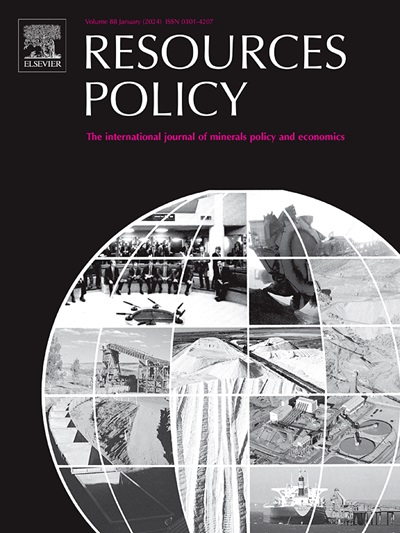Assessing the impact of small-scale mining activities on land use land cover and the sustainability of mining practices in Ghana: A case of the Atiwa East district
IF 10.2
2区 经济学
0 ENVIRONMENTAL STUDIES
引用次数: 0
Abstract
Small-scale mining (SSM), though an important economic activity, has caused extensive damage to water bodies, forest, agricultural land, threatening sustainability of man and the immediate environment. This is largely attributed to destructive and wasteful mining practices dominating the sector. This study assessed the impact of SSM activities on land use land cover and the sustainable practices in Ghana, using the Atiwa East District as case study. The study specifically focused on the spatio-temporal changes in land use land cover, the impact of SSM on land use land cover as well as the factors that influence sustainability in the sector. Two hundred and ten (210) respondents were selected for the study. The supervised spectral angle mapper classification algorithm in QGIS together with visual interpretation was used to classify images into various Land Use Land Cover (LULC) categories.
Results from the study show that between the years of 2007–2021, about 3578.69 acres of farmland and about 1127.93 acres of forest were lost to SSM and other land uses, such as built-up, while SSM gained about 3708.985 acres of land. The study also observed that managerial commitments and education and training have positive relationships with the adoption of sustainable mining practices and this was at 1 %, 5 % and 10 % significant levels. The study therefore concludes that management of SSM firms should be committed in adopting sustainable measures in their operations while monitoring institutions also ensure strict compliance to standards to achieve sustainability in the sector.
评估加纳小型采矿活动对土地利用、土地覆盖和采矿做法可持续性的影响:以阿提瓦东部地区为例
小规模采矿虽然是一项重要的经济活动,但对水体、森林、农田造成了广泛的破坏,威胁到人类的可持续性和直接环境。这在很大程度上归因于主导该部门的破坏性和浪费的采矿做法。本研究评估了SSM活动对加纳土地利用、土地覆盖和可持续实践的影响,以Atiwa东区为案例研究。该研究特别关注土地利用土地覆盖的时空变化、SSM对土地利用土地覆盖的影响以及影响该部门可持续性的因素。210名受访者被选中参与这项研究。利用QGIS中的监督光谱角映射器分类算法,结合目视解译,对不同土地利用土地覆盖(LULC)类型的影像进行分类。研究结果表明,在2007-2021年间,约3578.69英亩的农田和约1127.93英亩的森林被SSM和其他土地用途(如建筑)所损失,而SSM则获得了约3708.985英亩的土地。研究还指出,管理承诺、教育和培训与采用可持续采矿做法有积极的关系,这在1%、5%和10%的显著水平上。因此,该研究得出结论,SSM公司的管理层应致力于在其业务中采取可持续措施,同时监测机构也应确保严格遵守标准,以实现该部门的可持续性。
本文章由计算机程序翻译,如有差异,请以英文原文为准。
求助全文
约1分钟内获得全文
求助全文
来源期刊

Resources Policy
ENVIRONMENTAL STUDIES-
CiteScore
13.40
自引率
23.50%
发文量
602
审稿时长
69 days
期刊介绍:
Resources Policy is an international journal focused on the economics and policy aspects of mineral and fossil fuel extraction, production, and utilization. It targets individuals in academia, government, and industry. The journal seeks original research submissions analyzing public policy, economics, social science, geography, and finance in the fields of mining, non-fuel minerals, energy minerals, fossil fuels, and metals. Mineral economics topics covered include mineral market analysis, price analysis, project evaluation, mining and sustainable development, mineral resource rents, resource curse, mineral wealth and corruption, mineral taxation and regulation, strategic minerals and their supply, and the impact of mineral development on local communities and indigenous populations. The journal specifically excludes papers with agriculture, forestry, or fisheries as their primary focus.
 求助内容:
求助内容: 应助结果提醒方式:
应助结果提醒方式:


